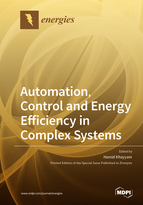Automation, Control and Energy Efficiency in Complex Systems
A special issue of Energies (ISSN 1996-1073). This special issue belongs to the section "F: Electrical Engineering".
Deadline for manuscript submissions: closed (30 December 2019) | Viewed by 47148
Special Issue Editor
Interests: artificial intelligence; machine learning and adaptive intelligent systems; limited and big data modelling; Industry 4.0 and Education 4.0
Special Issues, Collections and Topics in MDPI journals
Special Issue Information
Dear Colleagues,
Each year, around the world, a massive amount of energy is wasted through inefficient technologies, leading to an increase in greenhouse gas emissions.
Energy efficiency is an effective approach to improve energy consumption, as well reducing energy costs for consumers.
It is well established that engineering systems are often complex, uncertain, and nonlinear. These complex systems are in great need of computation and their processing has led to the use of automation control. As such, the energy efficiency of complex systems is of great importance and is the topic of discussion for this Special Issue.
The Special Issue aims to be a leading peer-reviewed platform and surveys the state-of-the-art and modern automation control techniques, and optimization algorithms, which are deployed to achieve complex energy efficiency. The Special Issue covers research on energy analysis, energy modelling and prediction, integrated energy systems, energy planning, and energy management to improve energy efficiency. In addition, papers are welcome on other related topics, such as renewable energy, electricity supply and demand, bioenergy, robot, vehicle, energy storage, energy conservation, energy in buildings, industrial and residential within the context of the broader automation control and energy efficiency.
Dr. Hamid Khayyam
Guest Editor
Manuscript Submission Information
Manuscripts should be submitted online at www.mdpi.com by registering and logging in to this website. Once you are registered, click here to go to the submission form. Manuscripts can be submitted until the deadline. All submissions that pass pre-check are peer-reviewed. Accepted papers will be published continuously in the journal (as soon as accepted) and will be listed together on the special issue website. Research articles, review articles as well as short communications are invited. For planned papers, a title and short abstract (about 100 words) can be sent to the Editorial Office for announcement on this website.
Submitted manuscripts should not have been published previously, nor be under consideration for publication elsewhere (except conference proceedings papers). All manuscripts are thoroughly refereed through a single-blind peer-review process. A guide for authors and other relevant information for submission of manuscripts is available on the Instructions for Authors page. Energies is an international peer-reviewed open access semimonthly journal published by MDPI.
Please visit the Instructions for Authors page before submitting a manuscript. The Article Processing Charge (APC) for publication in this open access journal is 2600 CHF (Swiss Francs). Submitted papers should be well formatted and use good English. Authors may use MDPI's English editing service prior to publication or during author revisions.
Keywords
- Modern energy efficiency techniques
- Vehicle/Robot energy efficiency
- Intelligent control of energy systems
- Big\limited data modelling of complex energy system
- Process optimization
- Energy storage, conservation, buildings, industrial and residential






